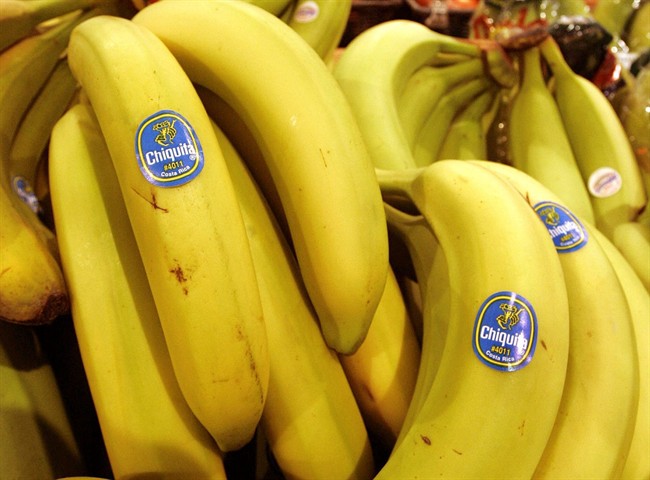Colombia has declared a state of emergency after a fungus which has caused devastation to banana crops in Asia was confirmed in its plantations — leading many to question whether the future of the fruit is in jeopardy.

Colombia is one of the world’s leading banana exporters after Ecuador, Costa Rica and Guatemala.
The first signs of the fungus were spotted in Northern Colombia in June. In July, the Colombian Agricultural Institute (ICA) in Bogota confirmed that four plantations in the northern part of the country were to be quarantined due to suspected infection with the fungus.
In a news release issued August 8, the ICA said it had received confirmation of the presence of the disease in 175 acres in La Guajira.
“We have received confirmation of the presence in Colombia of the fungus fusarium tropical type 4 (TR4), which is the causal agent for the wilt in 175 hectares planted with banana,” institute director Deyanira Barrero told Reuters.
But Barrero said the disease will not affect Colombian banana exports, adding that other countries where the disease has been detected have continued shipments abroad.
WATCH: Bananas growing at Halifax Public Garden for the first time

The ICA issued a national emergency declaration resolution, in order to “increase controls and have additional measures to address the situation in the affected area” and to “mitigate the risk of contagion to other regions.”
According to the release, on August 5, Colombia’s Minister of Agriculture, Andres Valencia Pinzon, met with representatives from 15 countries that supply the world banana market in order to discuss the actions implemented in Colombia to manage the situation.
The country has 50,000 hectares of banana plantations that generate about 30,000 direct jobs. It exported more than 100 million boxes of bananas in 2018 worth $859 million, mainly to the European Union and the United States.
What is fusarium TR4?
According to the Food and Agriculture Organization of the United Nations (FAO), the fungus fusarium, commonly known as “Panama disease,” is among the most destructive diseases of the banana plant.
The fungus lives in the soil and can lay dormant for 30 years. When active, it clogs the plant’s vascular system.
And while fruit from infected plants can still be consumed without risk, infected plants will eventually stop bearing fruit.
WATCH: Scientists invent world’s first edible banana peel

First detected in Southeast Asia in the 1990s, the tropical race 4 (TR4) version of the fungus has been identified in at least 19 sites in 10 countries.
It has infested banana plantations in southeast Asia and Pakistan, Jordan, Mozambique, Australia and now Colombia.
TR4 is of particular concern for the banana industry as it infects plantations growing Cavendish bananas, which dominate global trade.
Cavendish bananas are resistant to race 1 and 2 of the fungus which previously wiped out the Gros Michel variant — considered by some to be a finer variety than the bananas we know today — in the 1960s.
How does the fungus spread?
According to the FAO, infected soil particles can be moved by people, vehicles and animals, as spores can be carried on clothing, equipment or the soles of shoes.
The spores can also be carried in surface run-off water or irrigation water and can contaminate irrigation reservoirs.
WATCH: Spanish police seize over 6 tonnes of cocaine hidden in bananas

Flooding also plays a significant role in the spread of fungus, according to the FAO.
The fungus is resistant to fungicides and cannot be eliminated from the soil using chemicals.
Because there is no effective treatment, the FAO says prevention and quarantine are the most effective means of controlling the disease.
The end of bananas?
While fusarium TR4 poses a major threat to bananas, all hope may not be lost.
In a study published in Nature Communications in 2017, researchers with Queensland University of Technology were able to develop and grow modified, TR4-resistant Cavendish bananas.
Researchers modified Cavendish bananas with the RGA2 gene, taken from a TR4-resistant wild southeast Asian banana subspecies.
As a result, researchers found one modified Cavendish line remained fungus-free for three years of the 2012-2015 trial.
Three other lines modified with the gene showed “strong resistance” with 20 per cent or fewer plants exhibiting disease symptoms in three years.
Researchers found the RGA2 gene activity level was “strongly correlated” with the TR4 resistance.
Cavendish bananas have been found to have the RGA2 gene naturally, but it is not very active.
WATCH: Get Sparked: Who knew you could make a piano out of bananas?

According to the study, 67-100 per cent of the non-modified “control” banana plants were either dead or infected with TR4.
James Dale, a professor from QUT’s Centre for Tropical Crops and Biocommodities, said the outcome was a major step towards protecting the Cavendish global export business, under serious threat from TR4.
“These results are very exciting because it means we have a solution that can be used for controlling the disease,” Dale said in a 2017 news release.
“We have a Cavendish banana that is resistant to this fungus that could be deployed, after deregulation, for growing in soils that have been infested with TR4.”
WATCH: Here are the different health benefits bananas have during its ripe, unripe stages

According to Dale, while researchers cannot assert that the RGA2 gene is responsible for the resistance, they have established a correlation.
“We are aiming to find a way to switch that gene on in the Cavendish through gene editing,” he said in the release. “We’ve started that project. It is not easy, it’s a complex process that is a way off, with four or five years of lab work.”
“We’re also looking at as many genes as possible in the wild banana and screening them to identify other resistance genes, not only for resistance to TR4 but to other diseases,” he said.
— With files from Reuters




Comments